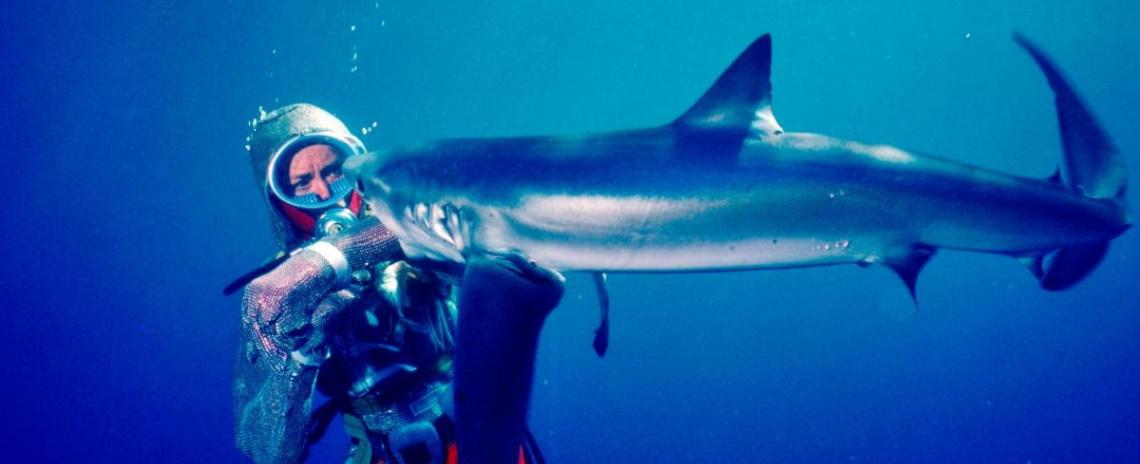Long before she was leading the charge to save them, Valerie Taylor was killing sharks. It’s not the kind of relationship one would expect from one of the most prominent voices in animal conservation. Jane Goodall, for instance, did not begin her fight to protect primates by poaching them, nor did Sir David Attenborough become a pillar of wildlife preservation by burning down rainforests. It is a key part of Taylor’s legacy nonetheless. Her long and renowned career is full of dissonance like this: Taylor strived to convince the public that sharks were more harmless than dogs but worked on more than one box-office smash that argued otherwise. She insisted they weren’t interested in attacking humans but brandished a scar from a shark bite on her chin like a badge of honor. For more than six decades now, Taylor’s unconventional and contradictory life story has done just as much to defend sharks as it has to perpetuate the harmful myths that surround the ocean’s most notorious predator. As complicated as her life’s work sounds, Sally Aitken’s documentary Playing with Sharks: The Valerie Taylor Story meticulously sets everything straight.
In the 1950s, Valerie Taylor was one of very few women — if not the only — involved in Australia’s booming professional spearfishing scene. She was immediately a standout for her fearlessness in the water, willing to dive down deep, pierce the most horrific-looking fish that men wouldn’t even dare to approach, and surface with a smile on her face and an award-winner on her spear. Taylor was iconic. Before long, she was moving onto bigger fish — literally. At this point in 20th-century oceanic history, sharks were seen as monsters of the deep, more terrifying and dangerous than any creature on land and entirely deserving of a swift and merciless death on sight. This sentiment, combined with the seemingly unlimited supply of underwater animals, meant that no one thought twice about skewering a fish, a crustacean, an octopus, or — in Taylor’s case — a shark. The regret set in instantly after that fateful dive in the 1960s, with the sight of a shark with a spear through the brain serving as an epiphany for Taylor. From that point on, she became more concerned with saving rather than slaying.
From then on, Taylor — along with her husband, Ron, an underwater photographer — tirelessly attempted to rehabilitate the image of the shark from fearsome to friendly. This was, of course, easier said than done: Given the creatures’ razor-sharp teeth, ink-black eyes, and undeniably aggressive aura, Taylor’s penchant for comparing sharks to canines was never going to work as she’d hoped. (One animal is fluffy, the other ... isn’t.) It also didn’t help that Ron and Valerie were front and center in the first feature-length shark documentary, Blue Water, White Death (1971), long considered to be the first of two major works of the 1970s responsible for maligning the shark as a human-killer to the general public. The other was Steven Spielberg’s Jaws (1975), for which the Taylors also happened to play an integral role. The couple are credited as camera operators for the film’s live shark footage, which — through some good old-fashioned Hollywood magic — helped bolster the illusion of a 25-foot shark that would very rarely be encountered in real life. Countless Jaws viewers were probably convinced — and some may still be to this day — that a massive shark like the one seen in the movie could approach them at any time in any ocean anywhere in the world.
Taylor had good intentions when she decided to work on Blue Water, White Death and Jaws, hoping to accurately portray the very real threat her beloved gentle giants can pose when provoked (and capture some incredible underwater footage in the process). However, the negative impact these two films had on the continued irrational fear of sharks cannot be overstated. No one realizes this more than Taylor herself. It’s remarkable how Aitken manages to paint her subject as both the hero and the villain of her own story, detailing her expertise in spearfishing and her subsequent efforts to put a stop to the barbaric sport, her desire to change the way sharks are perceived by the public and her later contribution in portraying them as omnipresent homicidal maniacs that will bite anyone who ventures into the dark and deadly sea. Playing with Sharks stands out for its willingness to go above and beyond the hagiographic standards of the biographical documentary subgenre and actually interrogate its subject a bit — and allow its subject the opportunity to offer up an apology and have a shot at redemption.
What’s great about Aitken putting all these complications and contradictions out in the open and allowing Taylor to meditate on them at the wise age of 85 is that it presents the viewer with a woman’s legacy that is as complex and flawed as anyone’s. A pioneer of both shark research and underwater filmmaking, a shark killer and a shark savior alike, Taylor is allowed to be imperfect and is all the better (and all the more captivating) for it. Combine this with some truly extraordinary 16mm underwater archival footage that crackles and pops with vibrant colors unlike anything that can be found in today’s textureless digital camerawork, Playing with Sharks is clearly a lot more than the basic-cable shark doc it appears to be on the surface. Sally Aitken and Valerie Taylor don’t just play with sharks: They grapple with them, wrestle with the species’ past, present, and future, consider all the ways in which humans have failed them, and make great strides to ensure less harm and more good.
Rating: B
Playing with Sharks is now available to stream from Disney+.


